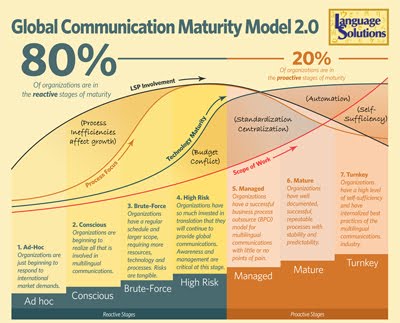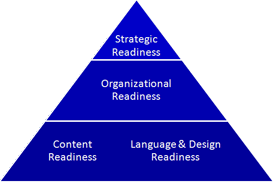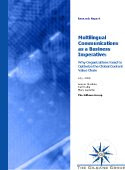In our model, we identified 2 stages of growth where conflict is at its highest point in the maturity of an organization: Brute-force and High-risk. The brute force stage is where conflicts start to impact project efficiencies. This is often a trial and error stage, but with potential long term effects as we have seen with organizations who have fallen back to low budget models as a method to control costs, without any return on the investment that they made beforehand.
Rather
than downplaying these conflicting stages of growth by focusing on ideal
situations, we emphasize and recognize these stages as
natural progressions of growth. We feel this is a departure from other models as
we embrace the conflict and define these stages as crucial success points on
the maturity model and ones that an organization must go through. It's the journey that can be impacted though...
Capability Maturity Model
Capability Maturity Model
The development of our Global
Communication Maturity Model was inspired by the Capability Maturity Model that
was used in the software industry. The
Capability Maturity Model was based on a set of structured levels that
describe how well the behaviors, practices and processes of an organization can
reliably and sustainably produce required outcomes.
Our idea was to come up with a similar benchmark model for our industry by which we could identify where a company is located on the maturity model and define key processes, objectives and metrics at each level to manage the localization process and growth. We had to look not only at the organization but at the individuals/departments/divisions/executive management within those organizations. We all know that we don't deal with organizations.....we deal with people in those organizations! (Tweet this!) In the model to the right, we align the readiness areas of our objectives for maturity with the people areas within an organization.
Reactive....not Proactive

Our model really focuses on the reactive stages (the first 4 stages of maturity). Buyers of translation services from 80% of organizations are most likely to overspend, impact quality and customer satisfaction. (Tweet this!) It is these buyers/organizations who can benefit most from prioritized strategies and objectives. These are the companies that will most likely benefit from best practices in the localization industry.
Even very large companies working with software localization and experiencing higher levels of maturity may not have this level of maturity throughout their whole organization. Many times, it is within one part of the organization but has not spread throughout. It reinforces the idea too that there really is no such thing as a mature business.
Even very large companies working with software localization and experiencing higher levels of maturity may not have this level of maturity throughout their whole organization. Many times, it is within one part of the organization but has not spread throughout. It reinforces the idea too that there really is no such thing as a mature business.
Natural Conflict Arises: Organizations that experience larger volumes of translation needs also have a growing awareness of the costs involved. Project inefficiencies also start to
compound as volume grows and it negatively impacts the decisions that are made
to move projects forward. Based on research and in our experience, a
sustainable growth model or maturity model is not self-evident to organizations and the people within them. At some point
of growth, conflicts arise between budget, time and quality needs.
The goal
of our model is to help buyers get through the stages of maturity and invest in
their translation and localization processes as it fits their business needs. A
maturity model can help buyers to see the road ahead and understand the goals
that they have in mind as their needs grow. Most importantly, when buyers enter
the brute-force stage, it is important to manage expectations ahead of time
because growth undoubtedly will lead to conflict if expectations are not
managed.
Organizations can be more proactive to look at the leading indicators that can influence their maturation rate and the pains that come along with it. Too many organizations focus on the lagging measures such as profit, ROI, etc. When you determine the lagging measures, there is nothing you can do about them. Common sense would tell us we need to go back and examine our historical markers as to how we got there.......
A Word to Language Service Providers
We know that there are other LSPs out there that do want to help organizations succeed. There is going to have to be a shift in our industry and a focus on helping organizations in the reactive stages. You may think that it is only the smaller companies who are in these reactive stages of maturity but a Watson Wyatt study found that 80% of organizations do not have a documented global communications strategy. It can be any size of organization and you can probably see your own clients there. What can we do together? We have tools that we have developed and are willing to share if you are an LSP that can effectively help your client. Give us a call or email and let's talk ....













